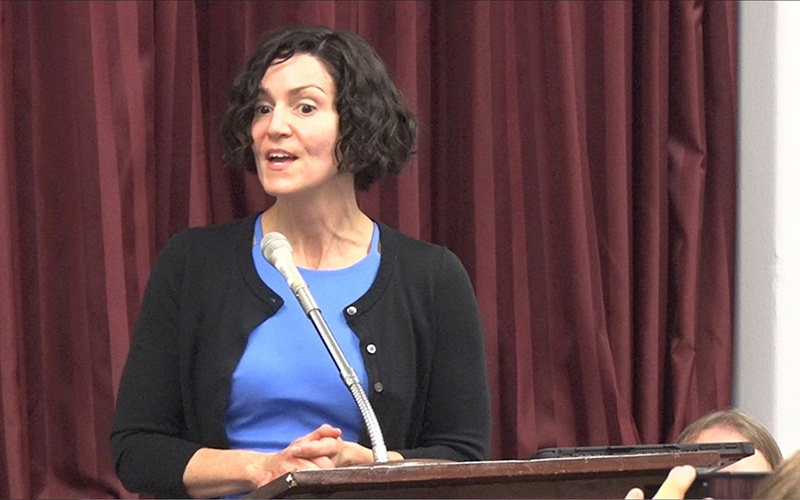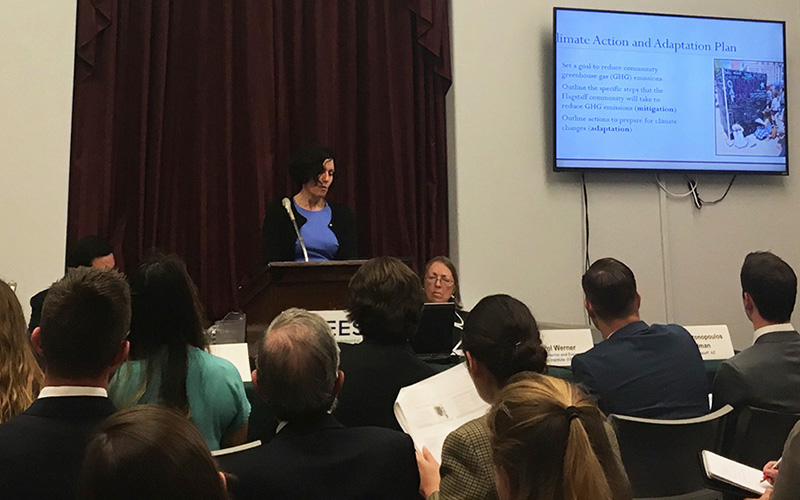
Flagstaff Sustainability Manager said the city began taking a systematic approach to building resiliency after a series of extreme weather events in 2010 that included the Schultz fire and a blizzard. (Photo by Bailey Vogt/Cronkite News)

Organizers said the session on building resiliency to the threat of extreme weather was planned before hurricanes pummeled the Gulf Coast, but that those storms show the need for cities to be prepared. (Photo by Isaac Windes/Cronkite News)
WASHINGTON – For Flagstaff, the wake-up call came seven years ago when the town suffered through the Schultz fire, a massive blizzard, floods, tornados and more.
Those events spurred city officials to develop a large-scale resilience project that Flagstaff Sustainability Manager Nicole Woodman displayed Monday as an example of how cities can learn from their past experiences to prepare for future calamities.
Organizers were quick to note that the event in Washington was planned before the recent hurricanes that slammed the Gulf Coast, but they said those storms – and wildfires raging over many Western states – show the need for cities to be prepared.
“Unfortunately, we’ve been witnessing extremes across our country,” said Carol Werner, executive director of the Environmental and Energy Study Institute. “There are so many people dealing with so many situations, whether it’s in the West dealing with fires or dealing with hurricanes in Texas and the Southeast.”
The institute and the National League of Cities co-sponsored the event, titled “How Can Cities Become More Resilient to Extreme Weather?” that brought together city officials to talk about what they have done.
Woodman said she sees Flagstaff’s experience as a possible blueprint for cities looking to develop systems to prepare for and respond to extreme weather.
“If you look at some of the framework of what Flagstaff currently has underway, those can absolutely be adopted by communities,” she said. But she urged cities to “make sure that they have sustainable funding.”
She said the city was able to fund one of those resiliency projects – the Flagstaff Watershed Protection Project – with the proceeds from a 2012 bond sale that was approved by almost 74 percent of voters. That project was developed in partnership with “the city of Flagstaff, the Forest Service, the state of Arizona, tribal nations, Northern Arizona University and a number of forest partnerships,” Woodman said.
But she said that bond revenue was just “seed money” for the project that protects the local watershed by thinning forests on federal land upstream – now officials are looking to find a sustainable funding source for the project, she said.
-Cronkite News video by Bailey Vogt
“Bonds are not a revenue-stable model to fund these programs,” she said. “But we are looking at other methods, and that’s the next step.”
Part of that comes from convincing taxpayers that sustainability and resiliency initiatives are a good use of tax dollars, said Woodman and other panelists, and by producing a finished project that they can see.
“What you have to do, and what we have done is tie economic impacts to these extreme weather events,” Woodman said. “We are fortunate that we are able to look at the economic impacts in Flagstaff.”
She said accurate record keeping is important to making those arguments.
“That massive snowstorm we had in 2010, the city did not keep detailed records on how much that cost. Are you kidding me?” she said. “Some of these smaller communities are not thinking strategically in that way.”
Woodman stressed the importance of cities taking a “systems approach” to prepare for extreme weather conditions in a changing climate, by evaluating risks and implementing policies accordingly. Moving forward, she said, costs are likely to rise as more extreme weather events continue to happen.
“We are in uncharted territory here,” she said.
Just as each city faces its own potential disasters based on its climate, each city must have its own plan, Woodman said. As much of the world looks toward coastal communities battered by hurricanes in the past week, Western cities like Flagstaff have a different set of worries.
“We already partner with our Western cities,” she said. “We aren’t talking about sea-level changes, but we are talking about fire, and drought and extreme temperature changes, and so we are using each other’s experiences and expertise as a resource library.”